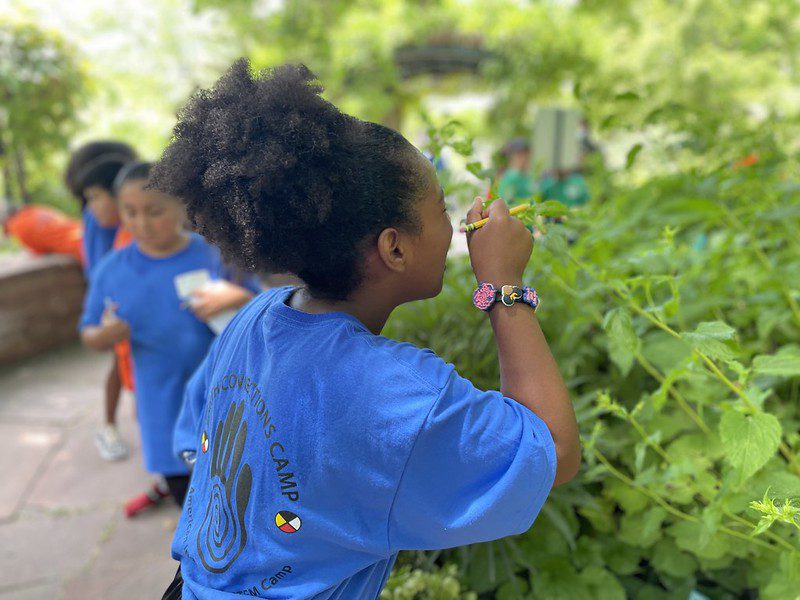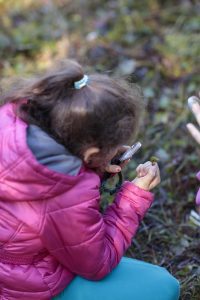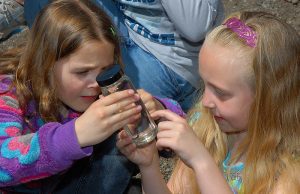If your school lacks natural spaces, it can be difficult to incorporate hands-on environmental learning for your students. Luckily, nature is persistent, resilient, and pervasive. There’s likely a wealth of natural resources that can become classroom fodder- and it’s much closer than you think! Students can easily love (or at least find fascinating) the smallest, grossest, weirdest manifestations of the natural world lurking in the corners of your school. Explore some ideas here for using nature to teach, even in urban environments or places where the natural world may not be so obvious.

Six Ideas for Nature Learning in Cities and Urban Areas
1. Explore School Grounds
Nature is everywhere, even in spaces that do not seem to be natural. Is your playground on concrete? I bet there is a line of ants walking to the trash cans. Don’t overlook any outdoor teaching area. Can’t go outside the school? There are deep dark corners of your building that are perfect habitats for creepy, crawly, and cool insects. Does your room have a window? There could very well be a bird highway in the sky or squirrel tree-playground across the street. Students love exploration. Give them the chance to quest for nature: provide a map of the school and grounds, and challenge them to find any and all nature-related things. Label all the nature on the map.
2. Elevate the Mundane with an Insect Adventure
Even if you’re not stoked on creepy crawlies or dirty messes, students absolutely can be! They’ll look to you for how to react when they find a daddy long-leg or cricket, or see a weedy plant growing in the cracks. You don’t have to love it to model curiosity and exploration. I Notice, I Wonder, It Reminds Me Of is a great routine to turn “oh, heck no!” into the “well, that’s interesting.” And for the really adventurous, collect some specimens to bring back to the classroom! It’ll change the critter from “creepy” to “class pet.”
3. Exploration Activities: Dig Deeper to Find the Nature
 When nature is hard to find, you have to get up, down, and close to make the best discoveries. Can students wiggle under bleachers, squeeze into the back of the maintenance closet, tour the ceiling corners of the administrative offices in search of nature? It’s most likely there, just waiting for moments of wonder. What you find may be small. Can you equip students with hand lenses to peek deeper into this new world? Use a lesson plan to unlock this powerful observation tool for students. Hand lenses aren’t in your budget? Just curl your hand into a tube to peer through. It will help you and your students focus and look carefully at small objects.
When nature is hard to find, you have to get up, down, and close to make the best discoveries. Can students wiggle under bleachers, squeeze into the back of the maintenance closet, tour the ceiling corners of the administrative offices in search of nature? It’s most likely there, just waiting for moments of wonder. What you find may be small. Can you equip students with hand lenses to peek deeper into this new world? Use a lesson plan to unlock this powerful observation tool for students. Hand lenses aren’t in your budget? Just curl your hand into a tube to peer through. It will help you and your students focus and look carefully at small objects.
4. Bring Nature Inside: Sparking Curiosity with Natural Specimens
It doesn’t take a lot of nature to spark intense curiosity. You can use an interesting stick, your specimen from the exploration of the school grounds, or a weird rock to fuel observation, critical thinking, and wonder. Turn your new class-pet-specimen into a habitat-building project: what does this creature need to survive? Can we make the habitat sustainable? Or use this lesson from the Beetles Project to turn a mystery object from a 1-minute glance-and-dismiss to a 15-minute marvel-and-learn.
5. Nature Journals for Kids: Focus on Observation
When you do not have a ton of natural objects at your disposal, it’s important to explore each one deeply. Nature journaling can be a great way to do this! John Muir Laws’ books (download my favorite one as a free PDF) guides teachers through this amazing practice. Check out the lesson Timeline, on page 61. Bring in a couple of potted mums in the fall, give one plant to each table pod, and use observation and journaling to guide a student-centered discovery of the life cycles of plants.
6. Outdoor Learning Opportunities in Your Community
 If it’s possible, get students outside! Use the wonderful observation and curiosity skills they learned in the school to explore the nature outside the school walls. Take a walk around the school block looking for plants, critters, even non-living things like the sun, clouds, and rain. Use those deep exploration skills (and hand lenses!) to dive into every little thing you find, hunting for wonder and sparking curiosity. Once you slow down and look, nature will become more obvious all over the place.
If it’s possible, get students outside! Use the wonderful observation and curiosity skills they learned in the school to explore the nature outside the school walls. Take a walk around the school block looking for plants, critters, even non-living things like the sun, clouds, and rain. Use those deep exploration skills (and hand lenses!) to dive into every little thing you find, hunting for wonder and sparking curiosity. Once you slow down and look, nature will become more obvious all over the place.
You may be able to connect your students to scientific studies happening in your neighborhood. Visit SciStarter to browse citizen science projects by age and location and find a study where students can participate near you. Or visit City Nature Challenge for ways to record data on the nature around your school for scientific analysis.
If you’re ready to take it a step further, there may be folks in your community that help engage students in the local environment. For example, PopEd trainer Karen Marshall connects students in New Orleans with science investigations in collaboration with scientists through Ripple Effect Nola and Sankofa. Regional affiliates of the North American Environmental Association maintain databases of organizations that get kids outside across U.S., Canada, and in various places around the world.
Yes, You Can Teach Environmental Education in a City
The natural world isn’t only accessible to rural and suburban schools. Habitats abound in all learning environments. The trick is being able to notice, appreciate, and share these natural nuggets in and around our buildings. And for educators without a lot of experience teaching in nature, hopefully these resources will give you a head start into that whole new world that already surrounds you.
Image credits: Student looking at plant (2022 Earth Connections Camp by BLM Utah is public domain); Student outdoors with magnifying glass (Student with a Magnifying Glass by Shenandoah National Park is public domain); Students examining captured bug (Youth Outdoor Education – Deschutes National Forest by U.S. Forest Service – Pacific Northwest Region is public domain)


